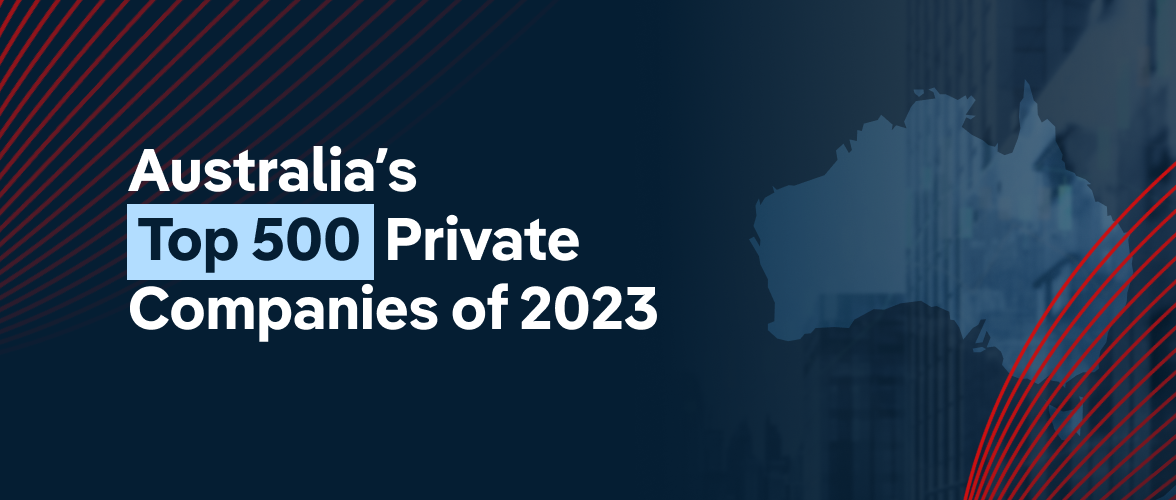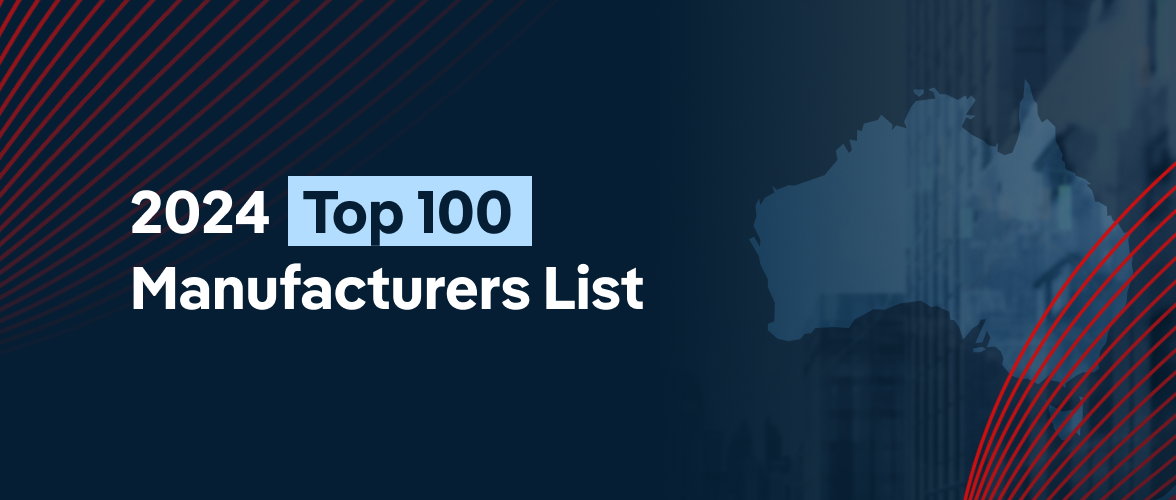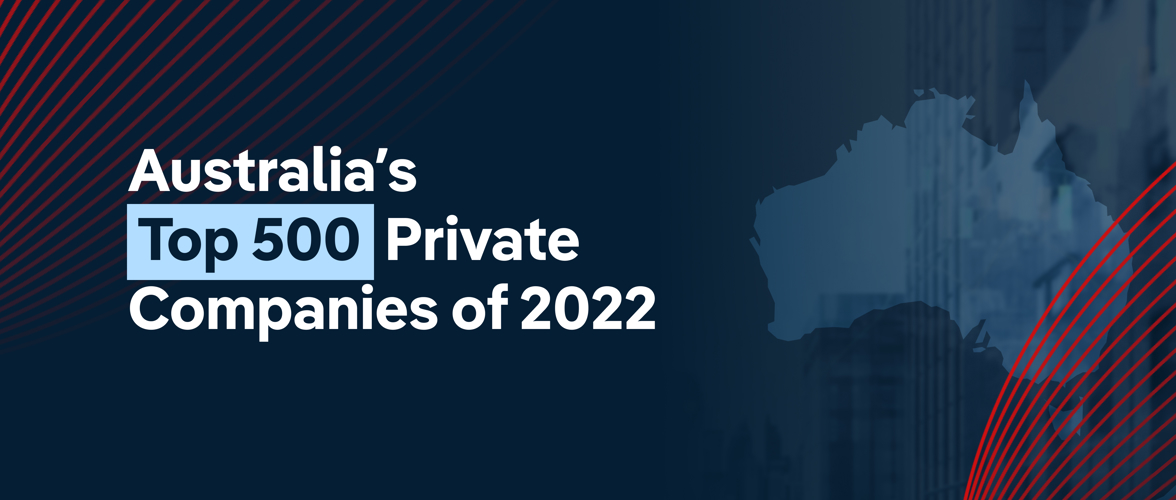Key Takeaways
- The Russian-Ukraine conflict brought both challenges and opportunities to Australian industries; a situation seized by CBH Group as the sole Top 500 representative in their sector.
- Rising input costs amid high inflation have crushed companies in the Construction division, despite revenue success for construction firms in the Top 500.
- Non-depository financiers and health insurance firms have taken advantage of interest rate hikes and seen their revenue surge.
- Used car prices have spiked as supply chain issues continue to disrupt the automotive industry.
- Government funding initiatives have inspired childcare providers to lift their prices and their revenue.
Welcome to our exclusive Top 500 special report, which provides a comprehensive and insightful analysis of the performance, trends and key players within the Australian private sector.
In a year shaped by geopolitical turmoil, economic uncertainty and unprecedented challenges, the Australian business landscape has continued to evolve at a rapid pace. In this special report, we delve into some remarkable stories and trends that have defined the past financial year.
From sectors affected by global crises to those flourishing in the face of adversity, this report offers a comprehensive overview of some of the most powerful stories from Australia's private sector.
To download IBISWorld’s Top 500 Private Companies List, fill out the form.
The 2023 Top 500 Private Companies List unveils a striking narrative of financial prowess among Australia's leading firms. Collectively, the Top 500 companies achieved a staggering total revenue of $333.6 billion. This figure reflects an impressive 20.5% increase over the combined $276.7 billion total of 2022’s list.
Even more compelling is the robust surge in the average revenue of these top companies. In 2023's Top 500, companies boasted an average revenue of $667.1 million, surpassing the previous year's average of $553.4 million. This expansion underscores the vitality and competitiveness of the Australian private sector.

So, what does the Top 500 list tell us about the state of Australia’s economy?
From Kyiv to Canberra: The Economic Reverberations of the Russia-Ukraine Conflict
Beyond the devastating human toll, the Russia-Ukraine conflict has sent shockwaves through the global economy, causing disruptions in various industries. Grain Storage is one Australian industry that has been significantly affected, and one company – CBH Group – has emerged as a standout player amid the chaos.
Boost in Australian Grain Value
One of the immediate consequences of the Russia-Ukraine conflict was the curtailment of the global grain supply. Ukraine, often referred to as the ‘breadbasket of Europe’, is a major exporter of wheat and other grains. However, the conflict disrupted its agricultural production and export capabilities, leading to a shortage in global grain supply. India’s ban on wheat exports only exacerbated these shortages.
In response to this disruption, Australia, another major player in the global grain market, saw a significant increase in the value of its grain. Higher demand for Australian grain, driven by global shortages, led to a spike in its market price. In fact, domestic wheat prices climbed by 17.5% in 2021-22 and a further 9.1% in 2022-23. As a result, Australia’s Grain Storage industry experienced a hefty surge in revenue.
CBH Group's Remarkable Growth
CBH Group has made headlines as the sole private company within the Top 500 operating in the Australian Grain Storage industry. In the wake of the Russia-Ukraine conflict, CBH Group recorded a staggering $2.0 billion rise in year-over-year revenue, marking the highest revenue leap among all industries covered in the Top 500. This surge equated to a 52.4% increase in revenue for CBH Group.
Price wasn’t the only catalyst for CBH Group’s revenue boom; increased grain volumes also played a vital part in the company's success. Grain growers have delivered 21.3 million tonnes into CBH Group's network – 30% more than any year before. While rising grain prices typically discourage demand for storage services, geopolitical tensions and supply chain issues limited such hurdles.
The Australian Grain Storage industry’s success has been unassailable, catapulting it from the 19th largest industry in 2022 to the 13th largest in 2023. This sharp rise is emblematic of the pivotal role CBH Group played in navigating the challenges posed by the Russia-Ukraine conflict.
Fuel Retailing in Australia and the Impact of Higher Oil Prices
The conflict also had indirect consequences on Australia’s Fuel Retailing industry. Two key factors contributed to these impacts:
- A rebound in economic activity from COVID-19: Economic activity increased significantly as the world began to recover from the pandemic-induced downturn, namely in transportation and manufacturing. Global demand for oil is surging in response, particularly from emerging economies like China. The average global oil consumption is expected to reach a record 102 million barrels per day (mbpd) in 2023 – up from 99.8 mbpd in 2022. This surge in demand for energy and oil have led to higher oil prices on the global market.
- Trade embargos with Russian oil: Trade embargos imposed on Russian oil producers in response to the Russia-Ukraine conflict disrupted global oil supply chains. Russia is one of the world's largest oil producers, and restrictions on its oil exports created further supply challenges.
Australian oil production was already volatile before the conflict began. Unviable margins drove two of Australia's four major oil refineries to cease operations in 2020-21, leaving Australia largely dependent on imports. With low refining capacity and reviving demand, this dependence has skyrocketed.
The combination of these factors resulted in a notable rise in oil prices in Australia, impacting both consumers and businesses. As oil prices ballooned, consumers faced higher costs at the pump, while businesses grappled with increased transportation expenses and manufacturing costs.

Inflation and Construction: A Balancing Act for Australian Builders
Inflation has affected industries across the board over the past year, and the Construction division in Australia is no exception. Specifically, the influence of inflation on two pivotal industries within the Construction division has been particularly noteworthy: Commercial and Industrial Building Construction and Multi-Unit Apartment and Townhouse Construction.
Why Construction Matters
The Construction division is a vital component of the Australian economy. The Commercial and Industrial Building Construction industry stands as the largest by revenue among private companies in the Top 500. The Multi-Unit Apartment and Townhouse Construction industry ranks in the top ten. What's striking is that Top 500 companies in both of these industries have demonstrated substantial growth, boasting year-over-year revenue increases of 13.0% and 15.0%, respectively.

The Paradox of Growth Amidst Bankruptcies
The impressive revenue leaps within these sectors seems paradoxical when viewed against the backdrop of increasing bankruptcies in the broader Construction division. This incongruity raises crucial questions about the downstream cost pressures faced by construction companies. While revenue is on the rise, an alarming number of players are facing insolvency, painting a complex picture of various construction industries' health.
Costs Outpacing Revenue
Private companies operating within the Commercial and Industrial Building Construction and the Multi-Unit Apartment and Townhouse Construction industries have borne the brunt of inflationary pressures. While these businesses have experienced some of the most substantial revenue hikes over the past year, these have not necessarily translated into profitability.
One key reason for this disparity lies in the inflationary environment. The costs of crucial inputs have been on a relentless upwards trajectory. For many construction companies, revenue growth has failed to keep pace with these surging costs. In some unfortunate cases, costs have actually grown faster than revenue, leaving companies struggling to stay afloat. The crisis has driven around 2,000 construction companies into liquidation over the past two years.
To illustrate this point, consider the example of Timber Wholesaling – an industry closely intertwined with the construction sector. Top 500 timber wholesalers witnessed a staggering 28.0% increase in revenue. While this seems like a promising development on the surface, it masks the harsh reality faced by construction companies. Timber prices have surged, and revenue spikes in construction may not be sufficient to offset these escalating costs.
Private Companies Face the Heat
Some construction firms have sought additional capital to navigate this turbulence – a task that is much more challenging for private companies than their public counterparts. For example, Simonds, the country's seventh-largest home builder, recently approached shareholders with a $25.5 million pro rata traditional renounceable entitlement offer. Without shareholders, loaning capital is often unfeasible for private firms, leaving them dependent on government funding.
From Rates to Revenue: Lenders and Insurance Firms Make Bank on Rising Interests
Higher interest rates have had a significant impact on various sectors of the Australian economy. Among the Top 500 private companies in Australia, the Non-Depository Financing industry has emerged as the fastest-growing, while the Health Insurance industry retained its position as the sixth-largest, posting a healthy 5% growth in revenue. These industries have demonstrated their ability to thrive as interest rates rise.
Non-Depository Financing
Strengthening Revenue
Higher interest rates have strengthened revenue for Top 500 private companies in the Australian Non-Depository Financing industry. This industry includes lenders who provide financing for various purposes, such as automotive, personal and business financing. Non-depository financing has gained massive popularity because of its product diversity and ability to cater to market niches. These alternate lenders also offer more flexibility and shorter wait times than banks, making them more attractive to borrowers.
With high interest rates on bigger loan books, non-depository financiers are prospering. Non-bank lenders currently account for about 5% of Australia's financial system. This number will likely rise as more borrowers turn to alternate lenders, particularly as they navigate the housing crisis.

Expenses in Line with Increases
It's important to note that corresponding expenses may have risen in line with these interest rate hikes. For instance, lenders in the Non-Depository Financing industry often maintain financing warehouses where the cost of capital is tied to benchmark rates, like the Australian cash rate set by the RBA. This rate can influence the cost of funds for lenders.
In practice, companies in this industry typically pass on the increased cost of capital to borrowers. For example, for every 50 basis points increase in interest rates, they may pass on a slightly higher rate, say 52 basis points, to cover the additional risk associated with higher rates. This practice helps mitigate the potential margin squeeze that lenders might experience when interest rates rise.
Health Insurance
Benefits for Insurers
The impact of higher interest rates extends beyond the financial sector to industries like Health Insurance. Health insurers, like HBF (a prominent private company in this space), have experienced notable benefits from rising interest rates, including:
- Premium increases with inflation: Health insurance companies hike their premiums in line with inflation. They essentially benefit from an inflationary environment, provided they maintain profitable underwriting practices, as measured by their combined ratio. This not only helps maintain profitability but also ensures that policyholders' coverage keeps pace with rising healthcare costs.
- Increased interest received on float: The money collected in premiums but not yet paid out for claims is referred to as ‘float’. Higher interest rates can boost interest income on this float, contributing positively to the insurer's bottom line.
Chips Down, Prices Up: Semiconductor Dilemma Contributes to a Bumper Year for Motor Vehicles
The Motor Vehicle Wholesaling and Motor Vehicle Dealers industries in Australia saw remarkable revenue increases, with private companies contributing significantly. Top 500 companies in the Motor Vehicle Wholesaling industry saw a staggering $1.1 billion revenue boost and the Motor Vehicle Dealers industry closely followed with a $1.0 billion leap, ranking fourth and sixth highest in revenue growth, respectively. These substantial gains can be attributed to unique circumstances over the past year.
In percentage terms, the growth story unfolds even more impressively. Top 500 motor vehicle wholesalers generated a 56.1% boom in revenue, underscoring the rapid expansion in this segment. Meanwhile, Top 500 motor vehicle dealers recorded a 7.6% increase, reflecting their resilience in adapting to changing market conditions.
A Semiconductor Shortage Rattles the Automotive Market
One of the most pervasive challenges to hit the automotive industry recently has been the global shortage of semiconductor chips. This scarcity of essential componentry has reverberated through the entire supply chain, leaving manufacturers with incomplete vehicles and disrupted schedules.
Globally, motor vehicle manufacturers have had to cut an estimated 19.6 million vehicles out of their production schedules between 2021 and 2023. Notably, US car manufacturer Ford had to temporarily halt production of its highly anticipated Mustang at its Michigan plant due to a lack of semiconductor chips.
The consequences of these shortages have been felt not only by international manufacturers but also by retailers and consumers in Australia.
Rising Used Car Prices Amidst New Car Delivery Delays
As new car deliveries faced substantial delays due to the semiconductor shortage, the Australian automotive market experienced a surge in used car prices. Australian motor vehicle dealers found themselves in a unique position as lengthy wait times turned consumers to the second-hand market to meet their immediate transportation needs. Dealers commanded prices well above the manufacturer's suggested retail prices, capitalising on the scarcity of new vehicles and driving their revenue up.
Pent-Up Demand After Years of Uncertainty
The years 2020 and 2021 were marked by significant economic uncertainty, affecting consumer behaviour and leading to a decline in new car purchases. However, as the economy stabilised and confidence returned, pent-up demand for new automobiles surfaced. Consumers who had postponed their car purchases sought to replace ageing vehicles or acquire new ones, providing a boost to the industry.
Tax Incentives Fuel Fleet Renewal
To further stimulate economic activity, the Australian government introduced tax incentives, like the Instant Asset Write-off. These incentives encouraged businesses to renew and expand their corporate fleets. Companies took advantage of tax breaks to upgrade their vehicles, contributing to an increase in sales for the automotive industry.
The Perfect Storm of Supply and Demand
The convergence of restricted semiconductor supply, increased demand and unforeseen shipping disruptions created a perfect storm for the Australian automotive industry. These conditions emboldened motor vehicle wholesalers to demand high prices. Price growth outpaced volume growth, which bolstered revenue and profits for Top 500 companies in Australia's Motor Vehicle Wholesaling industry.
Workforce Woes: Labour Shortages in Government Support Services
Private companies in the Aged Care Residential Services, Private General Hospitals, and Child Care Services industries in Australia have experienced significant revenue growth in the past year. Affinity Education Group, a key player in the childcare sector, posted the highest revenue growth of all Top 500 firms – at 255.2%. These industries have all shown impressive financial performances.
Yet, they have also become the focus of public attention and political discourse as the pandemic exposed ongoing labour shortages. Understanding the reasons behind labour shortages and the role of government support is crucial to grasp the dynamics of these industries.
Competing for a Scarce Resource
Intense competition for skilled workers is a key driver behind the labour shortages in these industries. Aged Care Residential Services, Private General Hospitals and Child Care Services all depend on a skilled workforce to deliver quality services. As demand for these services continues to rise, the competition for talent has led to companies offering higher wages and benefits to attract and retain employees. This competition has translated into higher prices for the public.
The Migration Factor
The shortage of skilled labour can be attributed, in part, to lower levels of migration in recent years. Migration has traditionally played a significant part in filling critical roles in the Australian workforce, particularly in health care and child care. The number of foreign students has fallen from a peak in 2019 due to the pandemic and its associated restrictions. Net migration has also plummeted, and became negative in 2021. Both figures, while improving in 2023, have failed to recover to pre-pandemic levels.
Reduced migration levels, due to both government policy changes and external factors, have strained the labour market in these industries. This shortage has further exacerbated the wage pressures faced by private companies, as they must offer more attractive compensation packages to secure the limited pool of available talent.
Government Support and Pricing Strategies
To address labour shortages, the Australian government has implemented various support measures, particularly in the Child Care Services industry. Government supplements and subsidies have been introduced to assist families with childcare costs – some subsidies cover up to 90% of childcare expenses. While these subsidies have been a relief for parents, they have also created an interesting dynamic in the industry.
Childcare providers are aware that their customers are heavily subsidised by taxpayers. The government's financial support has cushioned the impact on parents’ wallets, meaning demand for child care is less sensitive to price. Many providers have taken advantage of this leeway and raised their prices. Government support, combined with the labour shortage, has allowed some providers to hike prices without facing a substantial drop in demand.
Want to know more? Find out how to get access to dozens of data points on each company on our Top 500 list.
IBISWorld’s exclusive Top 500 Private Companies of 2023 list ranks Australian-owned private businesses, partnerships, co-operatives, associations, and non-listed public companies by annual revenue for the 2022-23 financial year. It has been published every year since 1992 and has appeared in leading business publications like the Australian Financial Review and The Australian.
The list provides readers with consolidated revenue figures, employee numbers and primary operating industries sourced from IBISWorld’s database of over 5,000 enterprises, in addition to estimated revenue figures based on company, industry and peer analysis.









